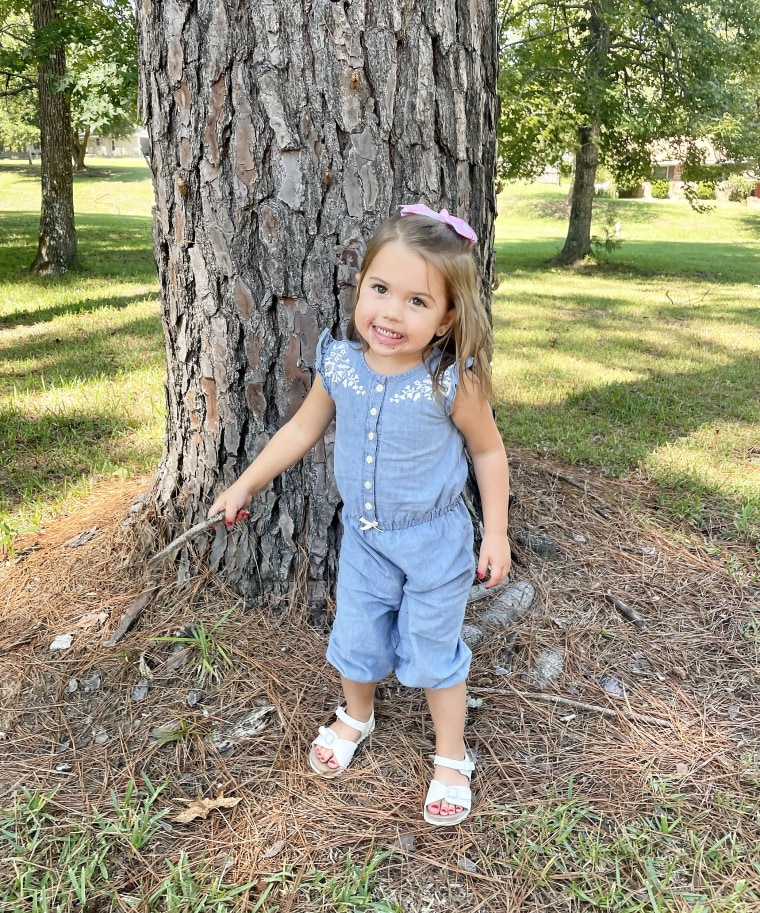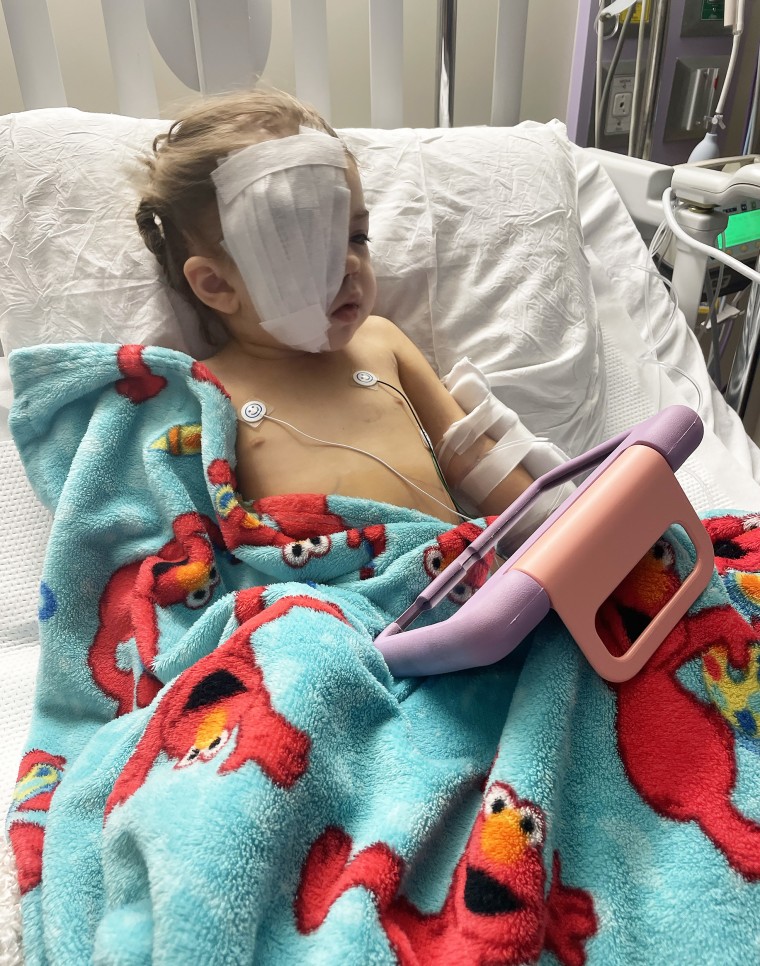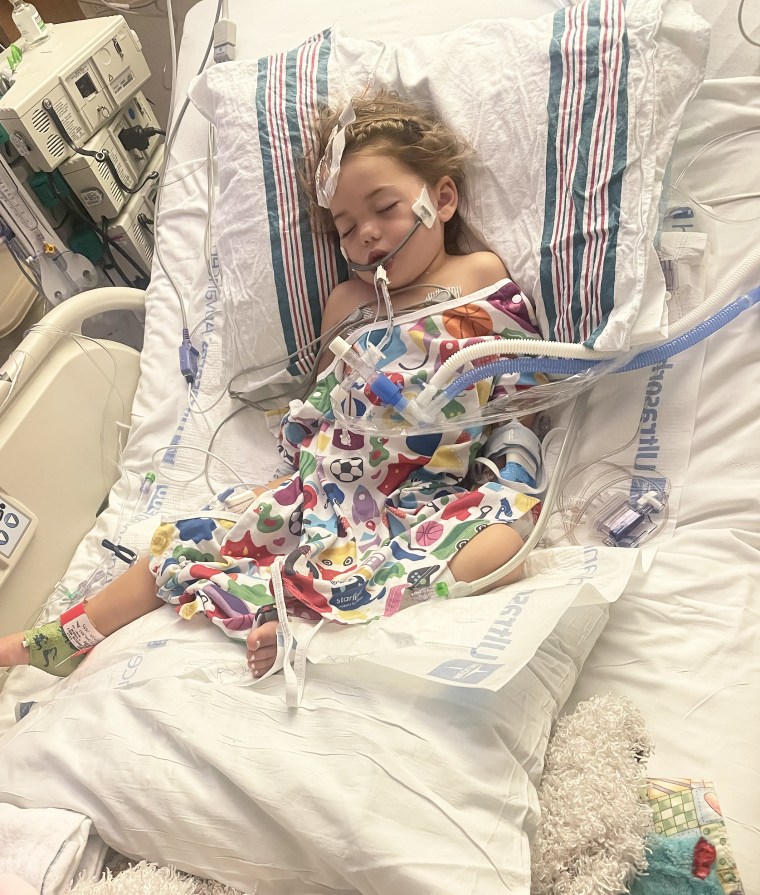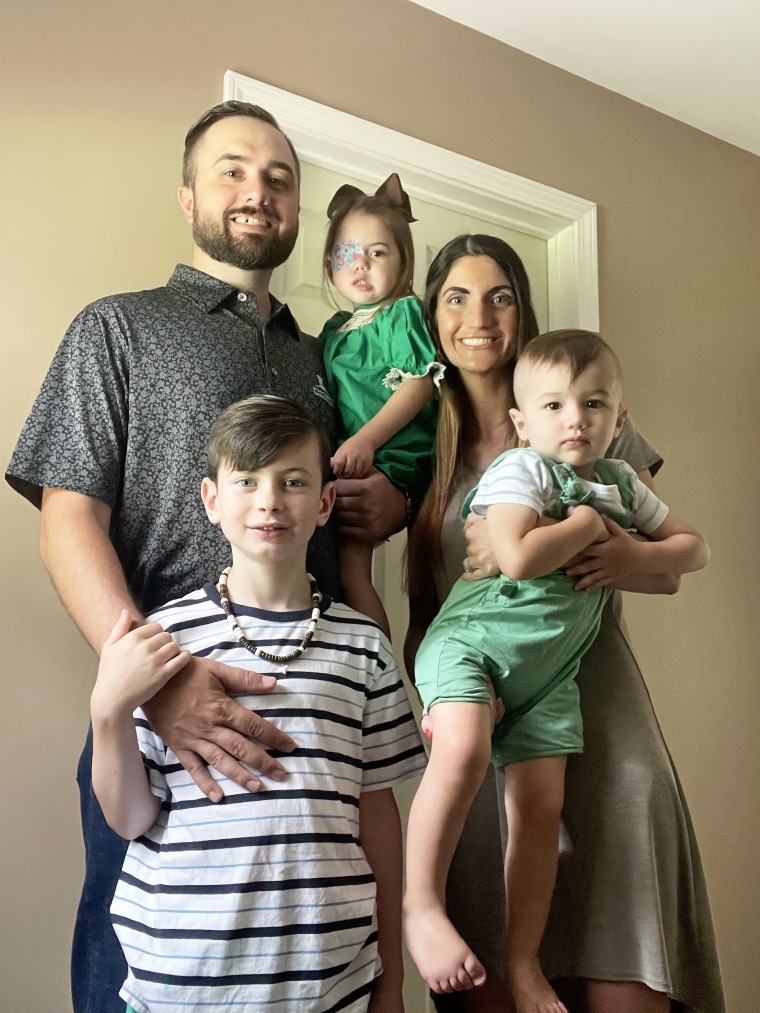Last year, Gracelyn Stiffler, then 2, began complaining of headaches and would point to the same spot behind her ear as the source of the pain. At first, mom Catherine Owens felt confused.
“She kept telling me her head hurts,” Owens, 29, of West Monroe, Louisiana, tells TODAY.com. “Then she started regressing. She was potty trained from 18 months old, and so when she started having accidents, I was like, OK, this is not normal.”One night, Gracelyn threw up, which made Owens worry that her daughter had a concussion. So, she took Gracelyn to the emergency room. They ruled out a concussion, but her symptoms worsened. After two visits to the pediatrician and another trip to the emergency room, Owens begged the staff for a CT scan of Gracelyn’s head. It revealed that the toddler had a mass in her brain.
“I knew it was something serious,” Owens says. “But I didn’t know it was a brain tumor.”

Worrisome symptoms that went dismissed
After Gracelyn started having headaches and accidents in the summer of 2023, Owens noticed that she was acting unusually. She began walking with her head tilted, and it seemed as if she was off-balance.
“She could still walk, but she was walking with her head titled,” Owens says. “I was like, ‘Maybe it’s just a stage she’s going through.’ I don’t know. … It just didn’t feel right.”
Then, after about a month of her strange symptoms, one night in September, Gracelyn began vomiting one night and couldn’t stop. Earlier, she had told her mom that she hit her head. Worried about a concussion, Owens took her to the emergency room.
“There was no bump. There was no indication that she hit her head, no red mark or anything,” she says. “When she started throwing up, a few hours later, I was like, ‘Oh my goodness maybe she does have a concussion.’”
Doctors tested her for several illnesses, and she tested positive for strep throat.
“They wrote her off,” Owens says. “They had told me that strep throat was what it was, and that she was so tired, so exhausted that she physically couldn’t hold her head up.”
This struck Owens as unusual, but she trusted the doctors and gave her daughter the medication as directed.
By October, Gracelyn’s symptoms hadn’t improved.
“She’s saying her head hurts, and she was throwing up off and on,” Owens says. “But it was clear mucous.”
This time, they visited the pediatrician, who thought perhaps Gracelyn was experiencing seasonal allergies.
“That made sense,” Owens says. “But I was more concerned about her head. I was like, ‘She keeps saying her head hurts, and it’s always in the same spot and I just don’t understand.’”
The pediatrician had an explanation for this.
“She was like, ‘Well, you always have migraines, so maybe she’s copying you,’” Owens recalls. “I didn’t really like that answer because I felt like she was writing her off.”
Frustrated, Owens made another appointment for a few weeks later and brought her husband to “back (her) up.”
Again, the doctor explained away Gracelyn’s symptoms and even suggested she return to wearing diapers, chalking up her regression to moving from a crib to a toddler bed and the birth of her brother, then 8 months old. The pediatrician also gave Gracelyn a prescription for physical therapy, occupational therapy and speech therapy.
But before they could schedule those appointments, Gracelyn once again started throwing up and couldn’t stop.

The same day, Owens had an appointment with the specialist who treated her migraines, so she asked the nurse to look at Gracelyn because she was so concerned by her daughter’s symptoms.
“She was the first person that actually heard me as a mother,” she says. “She’s like, ‘Yeah, something’s definitely wrong with her. I don’t know what, but if I were you, I would bring her to the ER and demand they do a CT scan.’”
When they arrived at the emergency room, though, staff insisted that the girl had “something viral,” Owens recalls. “I was like, ‘I respect you as a doctor, but I need you to respect my motherly instinct because something not right with her.”
Viral testing came back negative, so the doctors finally ordered a CT scan to ease Owen’s fears. It found that Gracelyn had masses on her brain, but more scans were needed to figure out exactly what they were. Gracelyn was rushed in an ambulance to a children’s hospital two hours away.
An MRI at the children’s hospital revealed she had a brain tumor and needed surgery within a few days.
Gracelyn had a Grade 2 ependymoma, which starts in ependymal cells in the central nervous system, according to the National Cancer Institute. While Grade 1 and 2 ependymomas are not considered cancerous, her tumor was “as close as it can be to cancerous,” Dr. Nir Shimony, a pediatric neurosurgeon at Semmes Murphey in Memphis and one of Gracelyn’s doctors, tells TODAY.com.
After a nine-hour surgery, doctors removed as much of the tumor as they could.
“It was intense,” Owens says. “They were confident that they had gotten (the tumor) all out.”
Still, the doctors sent Gracelyn’s case to St. Jude Children’s Research Hospital, and they eventually transferred Gracelyn there. Imaging at St. Jude revealed that some of the tumor was still nestled in Gracelyn’s brain, and doctors wanted to conduct another surgery to take more of it out. Doctors thought Gracelyn would respond better to radiation if she had as much of the tumor out as possible.
“It was just one shock after the next because we were not expecting another surgery,” Owens says.
Gracelyn experienced a few complications. A scratch and possible nerve damage to one eye led to loss of vision, and an injury to a nerve in her right ear means she is deaf in that ear. It’s unclear whether the vision and hearing loss will be permanent, Owens says.
In December 2023, Gracelyn started radiation and stayed at St. Jude until February 2024 for treatment. Gracelyn underwent more than two dozen rounds of radiation.
“Every day she would have PT, OT, speech, then she would have her treatment and sometimes she’d have to go to the eye clinic just to get things checked up,” Owens says. “We were constantly moving.”
Ependymoma
The tumor Gracelyn has, an ependymoma, is one that often impacts children.
“It’s a relatively, unfortunately, common tumor in this age group of infancy through the age of 3,” Shimony explains.

Gracelyn has a grade 2 ependymoma, which is “relatively aggressive,” and they can develop in the spine, the supratentorial area of the brain, where the cerebrum is, or the posterior fossa area, a spot near the cerebellum and the brain stem, Shimony says. Gracelyn’s tumor grew in the posterior fossa area.
According to the National Cancer Institute, symptoms of childhood posterior fossa ependymomas include:
- Neck pain
- Problems walking
- Balance troubles
- Fatigue
- Vomiting
- Acting easily annoyed
- A gaze that looks only downward
- Delayed development
- An enlarged head
Headaches sometimes can indicate a brain tumor. But Shimony urges caution in assuming that a child’s headache means they have a brain tumor.
“Kids can have headaches for many reasons,” he says. “Should we do a head scan for every kid with a headache? That’s dangerous. That’s a lot of head scans.”
Still, Shimony urges parents to take their children to their pediatrician if they have headaches to try to find the underlying cause.
“If the headache has no other reasons or there are other signs or symptoms — and especially if the headaches are something that is ongoing — it’s best to have a scan of the head, preferably an MRI, to rule out bad things,” he says.
Treatment for ependymoma include traditional cancer treatments, such as surgery and radiation.
“It is still what we call a surgeon’s disease, which means that surgery comes first,” he says. “Surgery will give the best option for better prognosis.”
Radiation normally follows surgery, along with follow-up appointments and scans to make sure the tumor has not returned or grown.
“If there is a residual tumor after everything that has been done, then it’s being followed carefully, and if this residual tumor is showing signs that it’s wanting to evolve or grow, sometimes we’ll go for another surgery or another treatment modality,” Shimony says.
Early diagnosis remains key in a child’s prognosis, and Shimony applauds Owen and other parents who advocate for their child in receiving a correct diagnosis.
“No parents would like to know that their kid has a brain tumor,” he says. “The one thing that has been shown across any type of tumor (for good prognosis) is early diagnosis. So, if the parents have a concern, if they see something they don’t like, they just need to make sure their kid is being taken care of.”
‘Always trust your mom gut’
Gracelyn returned home in February 2024, after four months in the hospital. She immediately played with her toys.
“She was ecstatic. She went straight to her playroom, and they did not go to bed that night,” Owens says. “We didn’t even care because we were just so happy to see her smile.”
Now 3, Gracelyn acts like a “little mama,” taking charge of her friends in day care when she attends. She loves knock-knock jokes and “cackles” at the punchline.
“She cackles at everything,” Owens says. “She is goofy.”

A little more than a month ago, Owens felt a hard lump in Gracelyn’s head when washing her hair. Owens thought a screw from one of her surgeries was coming out.
“It was perfectly round and it’s hard. It’s not like a cyst, where it is kind of squishy,” Owens says.
Owens took Gracelyn to the pediatrician, who agreed it seemed like a screw and recommended that the doctors at St. Jude fix it. Immediately, doctors knew the screw being loose could be dangerous for the girl.
“The pressure of putting her hat on or putting a headband on” could have caused the screw to rupture the skin on Gracelyn’s head, Owens explains. “If it ruptures, she’s at risk for infection.”
Again, Gracelyn needed to stay at St. Jude’s and undergo a surgery. She has recovered well.
“She’s perfectly fine. You wouldn’t even know it,” Owens says. “The next day, she was up decorating cookies.”
For now, Gracelyn doesn’t need additional treatment, only regular check-ups.
Owens shared her story on TikTok to encourage parents to “always trust your mom gut.”